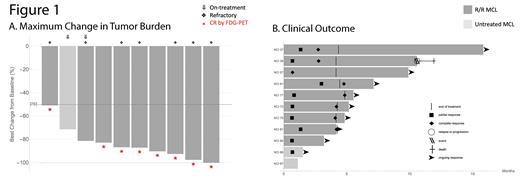Abstract
Background: Mantle cell lymphoma (MCL) is a biologically and clinically heterogenous B-cell lymphoma that is generally incurable with standard therapies. Novel targeted agents can disrupt key survival pathways in MCL such as regulation of apoptosis (BCL2: venetoclax), B-cell receptor signaling (BTK: ibrutinib), and NF-κB survival pathways (IRF4/SPIB: lenalidomide). As monotherapy, these agents fail to induce deep responses and doublet/triplet regimens often require continuous or maintenance therapy. ViPOR has been shown to be safe and active in non-MCL NHL pts without significant tumor lysis syndrome (TLS) (Melani et al. Blood. 2020; 136(Supplement 1):44-45). We hypothesized that combining agents that target multiple survival pathways with ViPOR will leverage efficacy and time-limited, cyclic dosing will limit toxicities in MCL.
Methods: Relapsed/refractory (R/R) and untreated MCL pts with adequate organ function were eligible. In R/R MCL, a phase I "3+3" design was used to determine the maximum tolerated dose (MTD) of 2 dose-levels of dose-escalated venetoclax (200mg and 400mg) PO D2-14 (starting C2) in combination with fixed-dose ibrutinib 560mg PO D1-14, prednisone 100mg PO D1-7, obinutuzumab 1000mg IV D1-2, and lenalidomide 15mg PO D1-14. A phase II expansion in untreated MCL was included at the MTD. ViPOR q21d x 6C was given without maintenance or consolidation. All pts were admitted C2 for 12d venetoclax escalation and TLS monitoring. All pts received TLS prophylaxis (ppx) with IVFs and allopurinol as well as PCP and G-CSF ppx. VTE ppx was per investigator discretion. Baseline CT, PET, BM, and tumor biopsy was performed with CT scans after cycles 1, 2, 4, and 6 and PET after cycle 6 or at time of suspected complete response (CR). Surveillance CT was performed q3m for 1y, q4m x 1y, q6m x 1y, then annually x 2y. Plasma for ctDNA was collected at baseline, prior to each treatment cycle, at each follow-up visit, and at disease progression.
Results: 11 pts have been enrolled and treated; 9 (82%) R/R in dose-escalation and 2 (18%) untreated in dose-expansion. Median age was 71y (range 57-79) with 73% >65y and 64% male. Low, intermediate, and high-risk MIPI occurred in 18%, 64%, and 18% of pts, respectively. Stage IV disease was seen in 91%, with BM involvement in 73%, extranodal disease in 82%, and both in 64%. Disease bulk >5cm occurred in 45% of pts. Blastoid morphology, Ki-67 >30%, and TP53 IHC >50% occurred in 27%, 36%, and 18% of pts, respectively. Median prior therapies in R/R pts was 3 (range 1-4) with 44% receiving prior BTKi, 11% receiving prior CAR-T, and 78% refractory (i.e., <PR) to last therapy. No pts received prior venetoclax or lenalidomide.
No dose-limiting toxicities (DLTs) occurred in 9 evaluable pts in the dose-escalation cohort; thus, venetoclax 400mg was used in expansion. G3-4 heme AEs (% cycles) included neutropenia (13%), anemia (11%), and thrombocytopenia (9%). No cases of febrile neutropenia occurred across 46 total cycles. G3-4 non-heme AEs (% pts) included hypokalemia in 3 (33%) pts as well as fatigue, hypomagnesemia, elevated bilirubin, atrial fibrillation, lung infection, and syncope in 1 (11%) pt each. No laboratory or clinical TLS occurred. Dose reductions and delays occurred in 5% and 15% of cycles, respectively.
Of 11 pts enrolled, 10 are evaluable for response (1 pt has not yet been restaged) with an overall response rate (ORR) and CR rate of 100% (10/10) and 80% (8/10), respectively (Fig 1A). Of 8 pts who have completed therapy, all 8 (100%) have achieved CR, including all 4 post-BTKi pts, 1 post-CAR-T pt, and 6 refractory pts. With a median potential f/u of 5.2m, median TTR and DOR was 0.7m and not reached, respectively, with 9 (90%) responses ongoing ranging from 0.3m to 14.5m after first response (Fig 1B). One pt with R/R blastoid MCL relapsed in the CNS 9.9m after initial response. Median PFS and OS were both not reached with 10 (91%) pts alive and progression-free and 1 relapse and death from progression at 11.9m.
Conclusion: ViPOR is safe in MCL without significant TLS or DLTs using a 12d venetoclax ramp-up on C2 and venetoclax 400mg was taken forward in expansion. Most common G3-4 AEs were hematologic with no febrile neutropenia observed when given with G-CSF ppx. High preliminary activity is noted in MCL pts with fixed-duration ViPOR x 6C, including CRs in refractory, post-BTKi, and post-CAR-T pts. Molecular and ctDNA analyses are ongoing and will be presented at the meeting.
No relevant conflicts of interest to declare.
Off-label use of ViPOR in relapsed/refractory and untreated MCL.


This feature is available to Subscribers Only
Sign In or Create an Account Close Modal